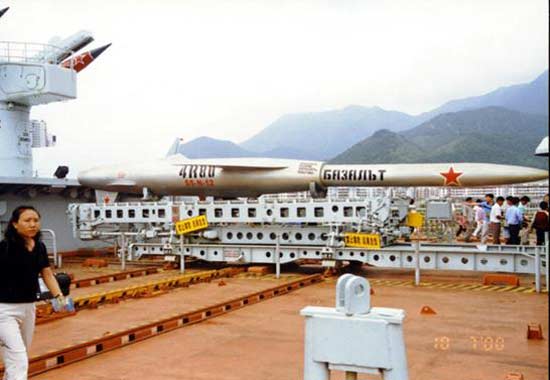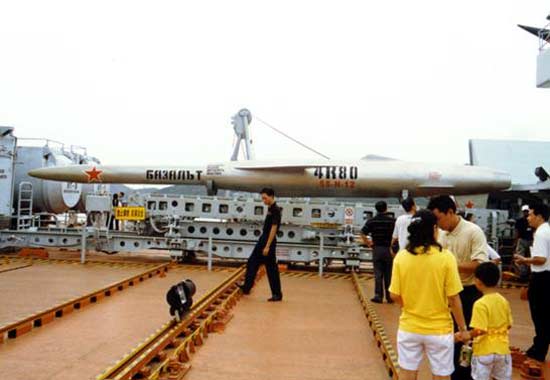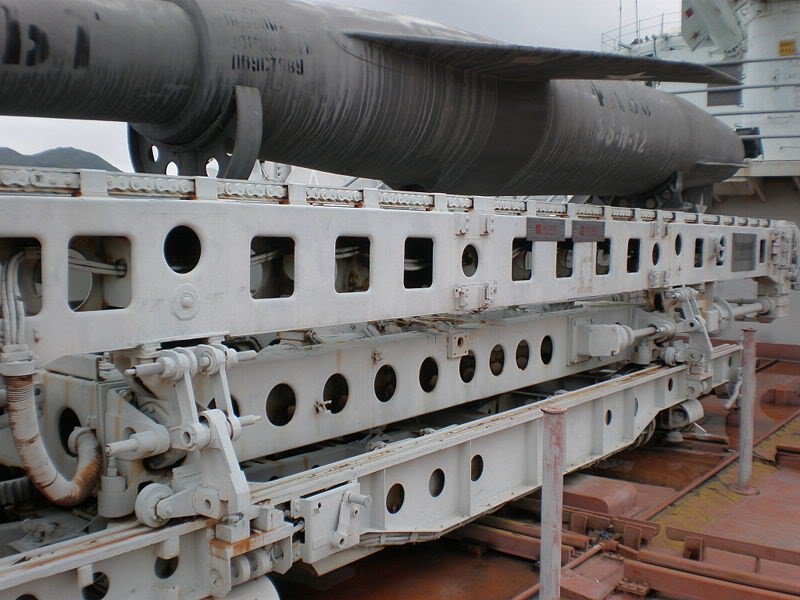P-500 Bazalt 4K-80
SS-N-12 Sandbox
SS-N-12 Sandbox is a Russian supersonic speed cruise missile with a range of 550 km carrying a payload of 1,000 kg. While no photographs of the ‘Sandbox’ missile (4K80) have been released, drawings believed to originate with intelligence sources do permit a description of the missile. It has a cylindrical body whose front is slim with a sharply pointed nose. Two-thirds of the way along it bulges before tapering towards the rear. The missile is powered by a turbo-jet and there is a small air intake about halfway along the body. The missile is believed to use a solid propellant booster to clear the launcher and enter the cruising phase. There are two short, swept-back wings which are believed to be folded when the missile is in its launcher. A triangular vertical stabilizer is at the top of the missile behind the wings and there is another on the underside at the tail. Two short, swept-back fins are located at the rear of the missile forward of the rear stabilizer.
The missile features command or inertial guidance with the option of mid-course updates. There is believed to be an active radar seeker for the terminal phase. The payload consisted of either a 1000 kg high explosive warhead or a 350 kT nuclear device, but the latter have now been removed. For Over-The-Horizon (OTH) targeting aircraft may also be used. These include the Tu-95 ‘Bear D’, the Ka-25 ‘Hormone B’ and the Ka-27 ‘Helix B’ with Big Bulge I/J-band radar.
The P-350 Bazalt [industrial code 4K-77] was the successor to the P-35 Bazalt, which was started in 1963 and subsequently cancelled. It evolved into the P-500 Bazalt [industrial code 4K-80] which was the production version of the original P-350 Bazalt. Development work for the SS-N-12 Sandbox began in the mid-1960s probably as part of the Eighth Five Year Plan (1966-1970), was apparently completed in 1973. Production was probably authorized as part of the ninth Five Year Plan (1971-1976). Some 500 missiles were produced but production has now ceased.
Developed to replace the SS-N-3 Shaddock anti- ship missile, it was initially deployed on the aircraft carrier Kiev in May 1975. The missile was later retrofitted into the ‘Echo II’ and ‘Juliet’ class submarines during the 1980s, replacing the SS-N-3. The ‘Juliet’ class is designated Cruise Missile Submarines in Soviet terminology.
The Slava-class cruisers carry an advanced version with an improved sophisticated guidance system, an autopilot that can be programmed for mid-course maneuvers, and an enhanced engine. The P-700 Granat [SSN-19 Shipwreck] was developed as a more successful turbojet alternative to the SSN-12 Sandbox, from which it was derived.
http://www.globalsecurity.org/military/world/russia/ss-n-12.htm











